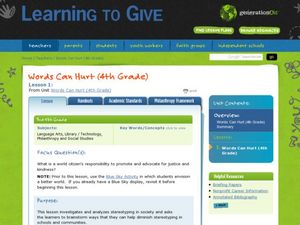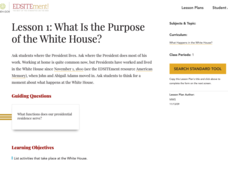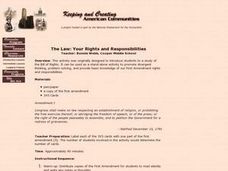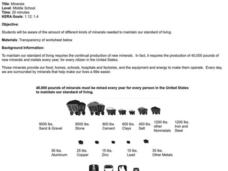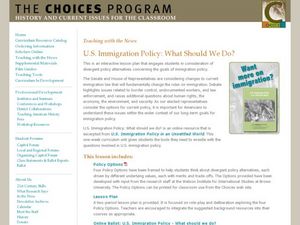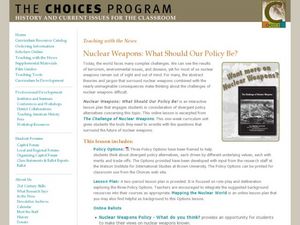Curated OER
The Ongoing Debate: Crime Control v. Due Process Protection
Students investigate the Exclusionary Rule and other ways of to enforce the protections found in the Bill of Rights. They study how effective criminal control and public safety is carried out while citizens Constitutional rights are...
Curated OER
The Immigrant Experience
Young scholars utilize oral histories to discover, analyze, and interpret immigration and migration in the history of the United States. A goal of the unit is fostering a discussion and encouraging students to make meaning of the bigger...
Curated OER
The National Motto
Second graders examine the meaning of the national motto, "In God We Trust." In this national motto lesson, 2nd graders explain some of the reasons why people selected the motto for the nation after viewing and discussing a coins and a...
Curated OER
Just how broken is the Senate?
Twelfth graders examine the role of the Senate in the United States. In this American Government lesson, 12th graders read various articles and answer questions to these articles. Students write a letter to their Senator on a...
Curated OER
HEALTH & SOCIAL SCIENCE
Young scholars use the information gathered from the Nick News Special Edition about homelessness. Each student creates a homeless collage poster featuring magazine and newspaper pictures and articles about the topic and a brief...
Curated OER
Words Can Hurt: King Day
Students explore stereotyping. In this moral and character development lesson plan, students share reactions to a T-chart displaying what boys can do and girls can not do. Martin Luther King's accomplishments are discussed, and...
Curated OER
We the People... How Does Government Secure Natural Rights?
Students investigate the Founders' ideas about what kind of government is most likely to protect the basic rights of people. They distinguish between limited and unlimited government.
Benjamin Franklin Tercentenary
Benjamin and the Way to A Good Life
Young scholars explore American history by reading biographical text in class. In this Benjamin Franklin instructional activity, students research the famous inventor by reading assigned text and answering reading comprehension questions...
Curated OER
The President and the Press ~ FDR's First Press Conference: March 1933
Students consider that many presidential aides now speak "off the record," in essence conveying a message from the president. They examine why most Presidents have fewer press conferences the deeper they get into their terms of office.
National Endowment for the Humanities
Lesson 1: What Is the Purpose of the White House?
Pupils view images of presidents working and living at the White House. They list activities that take place at the White House and discuss the many purposes of the building.
Curated OER
The Law: Your Rights and Responsibilities
Middle schoolers explore First Amendment rights and responsibilities.
Curated OER
What is Suffrage? Understanding the Right to Vote
Students discover one of the restrictions forced on women of the early 1900s. In this civil rights lesson, students investigate suffrage and why women were not allowed to vote in the early twentieth century. Students create a mock...
Curated OER
Minerals
Students become aware of the amount of different kinds of minerals are needed to maintain our standard of living by observing the worksheet. They study how it requires production of 40,000 pounds of new minerals and metals every year for...
Curated OER
The Russian Years: Back in the USSR
Students examine communist Russia. In this lesson on changes in politics, students work in small groups to compare and contrast soviet communist era citizen rights to those of the US. They participate in discussion of a film and create a...
Curated OER
Growing Voters and Election 2004: Get Out the Vote
Learners examine the voting process, the reasons citizens should vote, and participate in a community drive to sign up new voters. After looking at websites, students create a poster that outlines the reasons to vote, participate in a...
Curated OER
US Immigration Policy: What Should We Do?
Young scholars evaluate immigration policies. For this global issues lesson, students analyze the long-term goals of divergent immigration policies as they role play the deliberation process.
Curated OER
Hunger in the World
Background information is a great tool for any teacher. This resource provides background information on nutrition and world hunger, as well as ten different activity options to help learners understand this global issue. Each activity...
City University of New York
Presidential Elections and the Electoral College
To understand the controversy surrounding the US 2000 presidential election, class members investigate the rationale behind the Electoral Collage, the intimidation involved in the election of 1876, and the 2004 American League...
Levin Institute
Unit on Culture and Globalization
High schoolers explore the concept of cultural globalization. In this global issues lesson, students read and discuss the linked Web articles about world cultural issues and the dominance of the American market.
Curated OER
Nuclear Weapons: What Should Our Policy Be?
Students investigate nuclear weapons policies. In this global issues lesson, students research policies that the United States could institute to control nuclear weapon production. Students participate in a simulation to determine the...
Curated OER
Jimmy Carter: Civic Action, Lesson 1
Inspired by the humanitarian work of President Jimmy Carter after he left office, high schoolers explore the history of civic action in the United States and generate ideas about problems at the local, national, and international levels....
Curated OER
The Myth of Voluntary Internment
Students review the Alien Enemies Act and Executive Order 9095. They explore both the financial and emotional ramifications of having a parent arrested or interned. They research what daily life was like in U.S. Internment camps during...
Curated OER
Bill O'Rights
Students discuss and identify the first ten amendments to the Constitution and apply their understanding of the material to how they currently affect their lives. They discover the rights and responsibilities of being a citizen, and...
Curated OER
Texas Quarter Drawing
Students recognize the U.S. penny, nickel, dime, and
quarter by design and denomination and study the historical figures depicted on the coins. They study simple Texas symbols and choose
one to draw in a design for a Texas Quarter.





